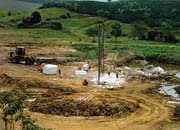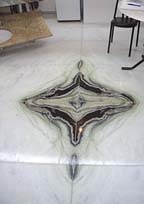

One of the most unique stone varieties extracted from the site is Paul Klee marble. This distinctive stone was named for a Swiss architect whose paintings followed abstract forms - from the veins of a leaf to the patterning of marble surfaces. Paul Klee marble has extremely distinctive veining in shades of light green, pink and gray, and unlike some white marble varieties, the stone is hard enough to be used as a countertop, as it is composed of 14% silica. This also makes the stone suitable for high-traffic areas such as staircases.
Another stone extracted from the Extra White Marble Quarry is Madreperola marble (literally translated as “Mother of Pearlâ€). This stone has shades of light and dark green, and a distinctive patterning that allows for creative book-matching.
A third material from the quarry is Argento, which is white with more traditional light gray veining.
The quarry produces 150 cubic materials of meters per month, with Paul Klee and Paul Klee light coming from a special layer of the quarry.
To extract the stone, workers use pneumatic drills and Pellegrini diamond wire saws from Italy. No blasting is needed, and as a result, production is optimized with very few cracks. A typical block is 6 to 7 cubic meters in size.
The stone is marketed toward a range of international destinations, including the U.S., and it is sold through Itaarte of Embu, Sao Paulo, Brazil.